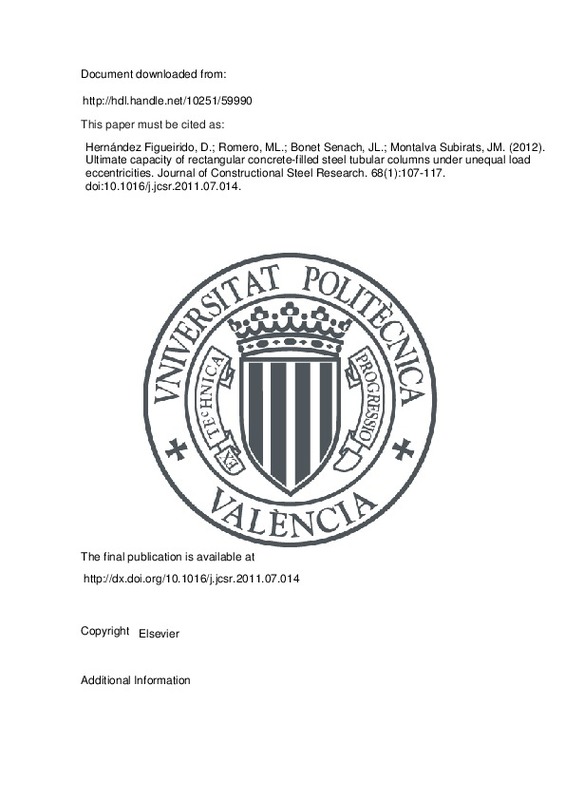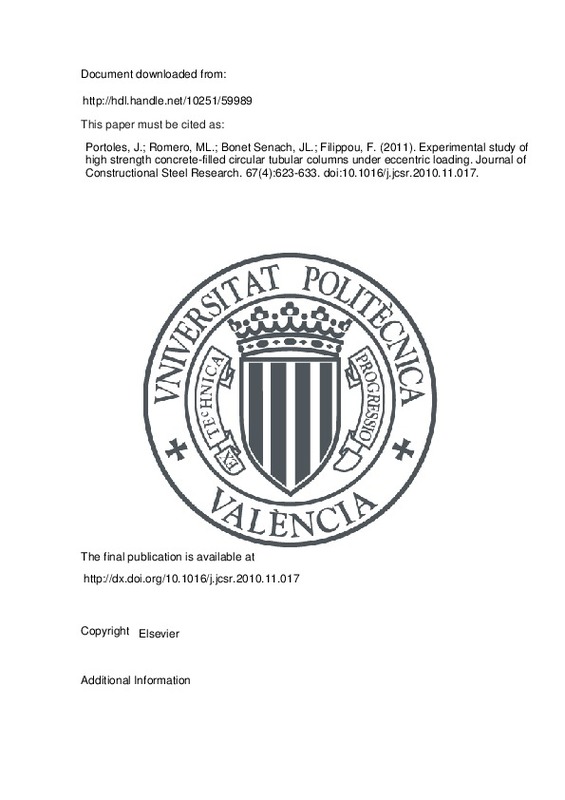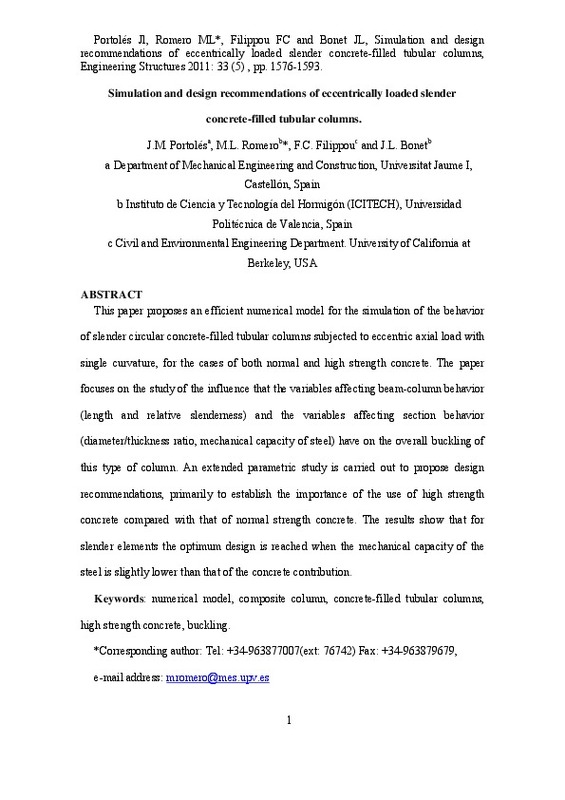Hernández Figueirido, D.; Romero, ML.; Bonet Senach, JL.; Montalva Subirats, JM. (2012). Ultimate capacity of rectangular concrete-filled steel tubular columns under unequal load eccentricities. Journal of Constructional Steel Research. 68(1):107-117. https://doi.org/10.1016/j.jcsr.2011.07.014
Por favor, use este identificador para citar o enlazar este ítem: http://hdl.handle.net/10251/59990
|
Título:
|
Ultimate capacity of rectangular concrete-filled steel tubular columns under unequal load eccentricities
|
|
Autor:
|
Hernández Figueirido, David

 Romero, Manuel L.
Romero, Manuel L.

 Bonet Senach, José Luís
Bonet Senach, José Luís

 Montalva Subirats, José Miguel
Montalva Subirats, José Miguel
|
|
Entidad UPV:
|
Universitat Politècnica de València. Departamento de Mecánica de los Medios Continuos y Teoría de Estructuras - Departament de Mecànica dels Medis Continus i Teoria d'Estructures
Universitat Politècnica de València. Departamento de Ingeniería de la Construcción y de Proyectos de Ingeniería Civil - Departament d'Enginyeria de la Construcció i de Projectes d'Enginyeria Civil
|
|
Fecha difusión:
|
|
|
Resumen:
|
The paper describes 36 experimental tests conducted on rectangular and square tubular columns filled with normal and high strength concrete and subjected to a non-constant bending moment distribution with respect to the ...[+]
The paper describes 36 experimental tests conducted on rectangular and square tubular columns filled with normal and high strength concrete and subjected to a non-constant bending moment distribution with respect to the weak axis. The test parameters were the nominal strength of concrete (30 and 90 MPa), the cross-section aspect ratio (square or rectangular), the thickness (4 or 5 mm) and the ratio of the top and bottom first order eccentricities e top/e bottom (1, 0.5, 0 and - 0.5). The ultimate load of each test was compared with the design loads from Eurocode 4, presenting unsafe results inside a 10% safety margin. The tests show that the use of high strength concrete is more useful for the cases of non-constant bending moment, whereas if the aim is to obtain a more ductile behavior the use of concrete-filled columns is more appealing in the cases of normal strength concrete with non-constant bending moments because, although they resist less axial force than the members with HSC, they obtain a softened post-peak behavior. © 2011 Elsevier Ltd.
[-]
|
|
Palabras clave:
|
Buckling
,
Composite column
,
Concrete-filled tubular columns
,
High strength concrete
,
Axial forces
,
Concrete filled steel tubular columns
,
Concrete-filled columns
,
Design load
,
Ductile behavior
,
Eurocodes
,
Experimental test
,
First order
,
High strength concretes
,
Load eccentricity
,
Moment distribution
,
Normal strength concretes
,
Post-peak
,
Safety margin
,
Strength of concrete
,
Test parameters
,
Tubular columns
,
Ultimate capacity
,
Ultimate loads
,
Aspect ratio
,
Bending moments
,
High strength steel
,
Spot welding
,
Tankers (ships)
,
Tubular steel structures
,
Bending tests
|
|
Derechos de uso:
|
Reserva de todos los derechos
|
|
Fuente:
|
Journal of Constructional Steel Research. (issn:
0143-974X
)
|
|
DOI:
|
10.1016/j.jcsr.2011.07.014
|
|
Editorial:
|
Elsevier
|
|
Versión del editor:
|
http://dx.doi.org/10.1016/j.jcsr.2011.07.014
|
|
Código del Proyecto:
|
info:eu-repo/grantAgreement/MICINN//BIA2009-09411/ES/Comportamiento Resistente Frente A Altas Temperaturas De Perfiles Tubulares De Acero Rellenos De Hormigon De Alta Resistencia/
info:eu-repo/grantAgreement/MEC//BIA2005-00255/ES/Estudio Numerico-Experimental del Pandeo de Perfiles Tubulares de Acero Rellenos de Hormigon de Alta Resistencia/
|
|
Agradecimientos:
|
The authors wish to express their sincere gratitude to the Spanish Ministry of Education for the help provided through projects BIA2005_255 and BIA2009_9411, and to the European Community for FEDER funds.
|
|
Tipo:
|
Artículo
|







![[Cerrado]](/themes/UPV/images/candado.png)




